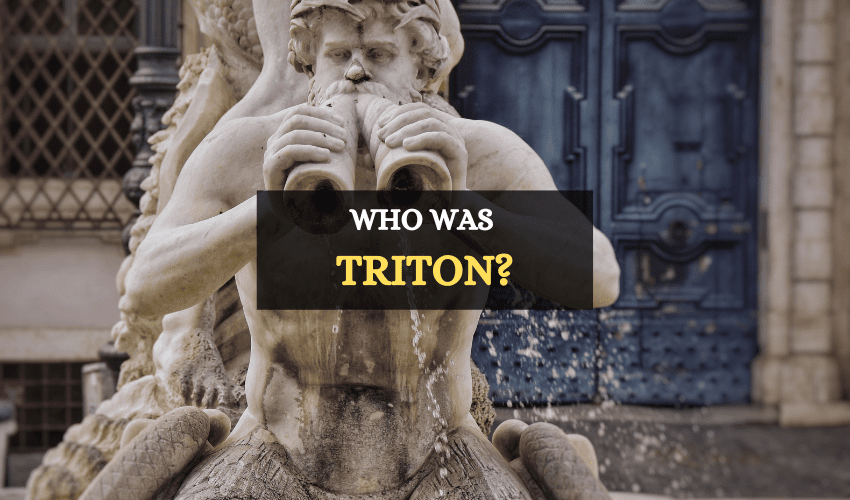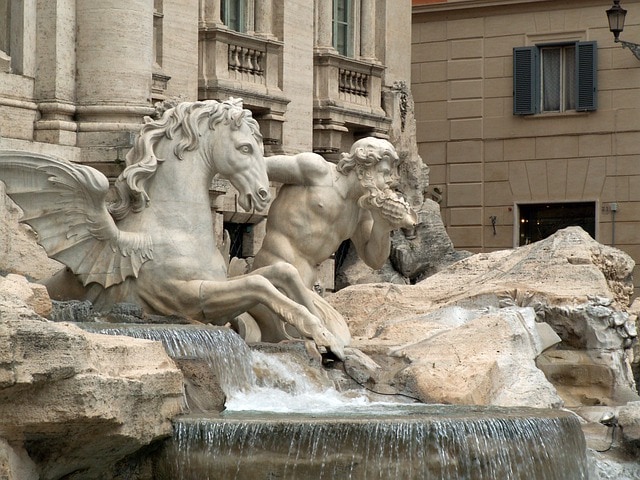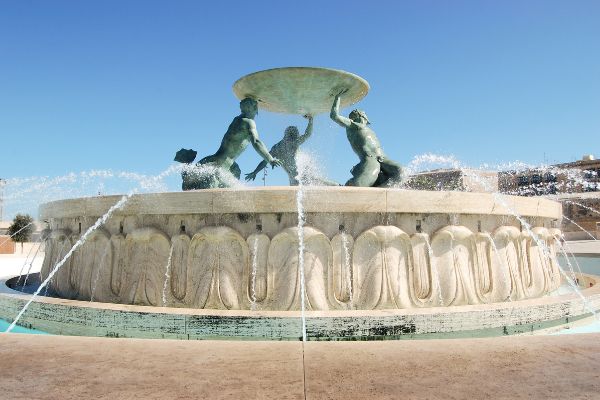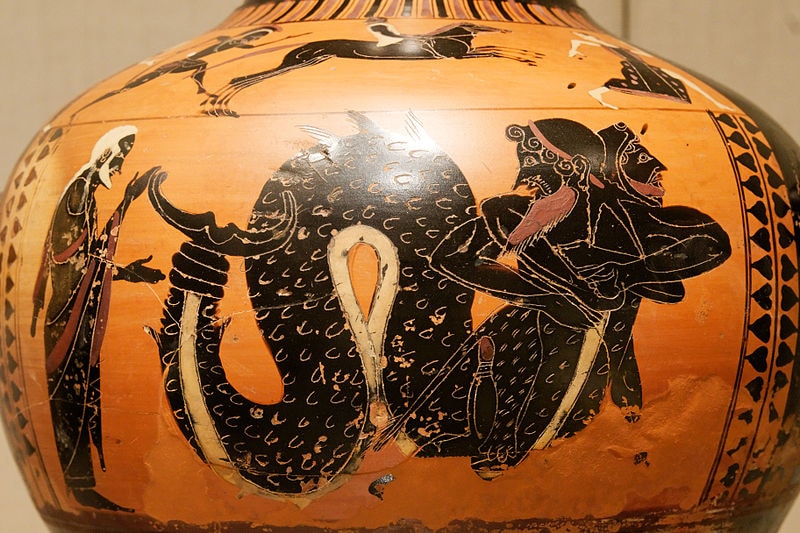
Table of Contents
Mysterious, powerful, and possibly the most famous of all Poseidon’s sons, Triton is a god of the sea.
Initially Poseidon’s prime herald, the representation of this deity in mythology has changed considerably through time, to the point of being portrayed either as a monstrous sea creature, hostile to humans, or as the resourceful ally of some heroes in different periods.
Today, however, people use ‘triton’ as a generic name to refer to mermen. Keep reading to know more about one of Greek mythology’s most exciting sea divinities.
Who Was Triton?
Triton is a divinity of the sea, son of the god Poseidon and the goddess Amphitrite, and brother to the goddess Rhode.
According to Hesiod, Triton lives in a golden palace with his parents in the depths of the seas. Triton is often compared with other sea divinities, such as Nereus and Proteus, but he is not portrayed as a shapeshifter, unlike these two.

Traditional depictions show him as having the appearance of a man down to his waist and the tail of a fish.
It wasn’t uncommon for Poseidon’s sons to inherit the compulsive character of his father, and Triton is not an exception, since he was known for abducting young maidens that were inadvertently taking baths seaside or next to a riverbank to rape them.
There are mentions in Greek mythology of a short-lived love between Triton and Hecate. However, his consort is the nymph Libya as his wife.
Triton had two daughters (either with the latter or with an unknown mother), Triteia and Pallas, whose destinies were deeply influenced by Athena. We’ll come back to this later, in the section regarding the myths of Triton.
According to Ovid, Triton could manipulate the force of the tides by blowing his conch-shell trumpet.
Symbols and Attributes of Triton
The main symbol of Triton is a conch seashell that he uses to control the tides. But this trumpet also has other uses, which might give us an idea of how strong this god indeed was.
During the war between the Olympians and the Gigantes, Triton frightened the race of giants, when he blew on his conch shell, as they believed that it was the roar of a wild beast sent by their enemies to kill them. The Gigantes fled in fear without a fight.
Some painted Greek vessels seem to suggest that as Poseidon’s herald, Triton used his conch shell to command all the minor deities and sea monsters that constituted the entourage of his father’s court.
Although the trident was mostly associated with Poseidon, artists began to portray Triton bearing a trident during the late classical period. These depictions might indicate how close Triton was to his father in the eyes of ancient viewers.
Triton is the god of the sea depths and of the creatures that dwelt in there. However, Triton was also adored inland, as people thought that he was the lord and guardian of certain rivers. The River Triton was the most famous of all. It was next to this river that Zeus gave birth to Athena, which is why the goddess receives the epithet of ‘Tritogeneia’.
In ancient Libya, the locals consecrated Lake Tritonis to this god.
Representations of Triton
The traditional depiction of Triton, that of a man with a fishtail, has been represented with some peculiar variations across time. For example, in a 6th century BC Greek vessel, Triton is portrayed with a serpentine tail with several pointy fins. In classic Greek sculpture, Triton also sometimes appears with a double dolphin tail.
Triton’s portrayals have also included parts from crustaceans and even equine animals at some points. For instance, in one Greek mosaic, the sea god is depicted with a pair of crab claws instead of hands. In another representation, Triton has a set of equine legs in the frontal part of his fishtail. It’s worth mentioning that the correct term for a triton with legs is centaur-triton or ichthyocentaur.
Several classical Greek and Roman authors also agree in saying that Triton had cerulean or blue skin and green hair.
Tritons and Tritoness – The Daemons of the Sea

At some point between the 6th and the 3rd century BC, Greek people began pluralizing the name of the god, referring to a group of mermen that sometimes appear either accompanying Triton or alone. Tritons are often compared to satyrs because they both are wild, semi-anthropoid creatures driven by lust or sexual desire.
It’s a common misconception to think that a female triton is called a siren. In ancient literature, sirens were originally creatures with bird bodies and a woman’s head. Instead, the correct term to use is ‘tritoness’.
Some authors consider that tritons and tritonesses are daemons of the sea. According to most ancient sources, a daemon is a spirit that embodies a particular aspect of the human condition. In this case, these creatures could be regarded as the sea daemons of lust because of the insatiable sexual desire attributed to them.
Triton in Art and Literature
Depictions of Triton were already a popular motif in Greek pottery and mosaic making by the 6th century BC. In both of these arts, Triton appeared as either the majestic herald of Poseidon or as a ferocious sea creature. Two centuries later, Greek artists began to represent groups of tritons in different art forms.
The Romans, who inherited the Greeks’ taste for sculpture and voluminous forms, preferred to portrait Triton with a double dolphin tail, a rendition of the god that can be traced back at least to the 2nd century BC.
After the renewed interest in Greco-Roman mythology brought by the Renaissance, sculptures of Triton began to appear once again, only this time, they would become a notorious fountain’s decorative element or the fountain itself. The most famous examples of this are the sculpture Neptune and Triton and Triton Fountain, both by the renowned Baroque Italian artist Gian Lorenzo Bernini. In both of these artworks, Triton appears blowing his seashell.
Mentions of Triton, or of groups of tritons, can be found in several literary works. In Hesiod’s Theogony, the Greek poet describes Triton as an “awful” god, probably referencing the temperamental nature attributed to this divinity.
Another brief but vivid depiction of Triton is given to us by Ovid in his Metamorphosis, in the recount of the Great Deluge. In this part of the text, Poseidon lays down his trident to calm the waves, while at the same time, the “sea-hued” Triton, whose “shoulders were barnacled with sea-shells”, blows his conch to bid the floods to retire.
Triton also appears in Argonautica by Apollonius of Rhodes to help the Argonauts. Until this point of the epic poem, the Argonauts had been wandering for some time into the Libyan desert, carrying their ship with them, and unable to find their way back to the African coast.
The heroes found the god upon arriving at Lake Tritonis. There Triton, disguised as a mortal called Eurypylus, indicated to the Argonauts the route they had to follow to get back to the sea. Triton also gifted the heroes with a magical cloud of earth. Then, understanding that the man in front of them was a deity, the Argonauts accepted the present and took it as a sign that their divine punishment was finally over.
In the Roman novel The Golden Ass by Apuleius, tritons are also shown. They appear as part of the divine entourage accompanying the goddess Venus (Aphrodite’s Roman counterpart).
Myths Featuring Triton
- Triton and Heracles

Despite not being recorded in any written source, the famous motif of Heracles wrestling Triton, depicted on many Greek vessels from the 6th century BC, suggests that there was one version of the myth of the twelves labors where the sea deity played an important role. Furthermore, the presence of the god Nereus in some of these representations has led mythographers to believe that the clash between these two formidable opponents might have taken place during the eleventh labor.
Heracles had to bring his cousin Eurystheus three golden apples from the Garden of the Hesperides on his eleventh labor. However, the location of the divine garden was secret, so the hero had first to discover where it was to accomplish his mission.
Eventually, Heracles came to learn that the god Nereus knew the path to the garden, so he went on to capture him. Given that Nereus was a shapeshifter, once Heracles caught him, the hero was extra cautious not to loosen his grip before the god revealed the exact position of the garden.
However, the vessel art mentioned above seem to suggest that in another version of the same myth, it was Triton who Heracles had to face and dominate to know where the Garden of the Hesperides was. These images also show that the combat between the hero and the god was a display of brutal force.
- Triton at Athena’s Birth
In another myth, Triton, who was present during the birth of Athena, is assigned by Zeus with the mission of bringing up the goddess, a task that he performed thoroughly until a very young Athena accidentally killed Triton’s daughter Pallas while playing.
This is why when invoking Athena in her role of goddess of strategy and warfare, the epithet ‘Pallas’ is added to Athena’s name. Another daughter of Triton, called Triteia, became a priestess of Athena.
- Triton and Dionysius
A myth also narrates a clash between Triton and Dionysius, the god of winemaking and festivity. According to the story, a group of priestesses of Dionysus was celebrating a festival next to a lake.
Triton suddenly emerged from the waters and tried to abduct some of the presents. Scared by the sighting of the god, the priestesses invoked Dionysus, who came to their help, producing such an uproar that he immediately repelled Triton.
In another version of the same myth, having watched what Triton had done to their women, some men left a jar full of wine next to the lake where Triton presumably lived. Eventually, Triton was drawn out of the water, attracted by the wine. The god started to drink it until he was very drunk and fell asleep on the earth, thus giving the men who had set up the ambush the opportunity to kill Triton using axes.
One interpretation of this myth is that it represents the victory of culture and civilizations (both embodied by the wine) over the irrational and savage behaviors represented by Triton.
Triton in Pop Culture
A gigantic Triton appears in the 1963 movie Jason and the Argonauts. In this film, Triton holds the sides of the Clashing Rocks (also known as the Cyanean Rocks) while the Argonauts’ ship penetrates through the passage.
In the Disney 1989 animated movie The Little Mermaid, King Triton (Ariel’s father) is also based on the Greek sea god. However, the inspiration for this film’s story mainly came from a tale of the same name written by the Danish author Hans Christian Andersen.
Conclusion
Son of Poseidon and Amphitrite, Triton is described as both a great and an awful god, given his physical strength and character.
Triton is an ambivalent and mysterious figure, sometimes considered an ally of heroes and, on other occasions, a hostile creature or dangerous to humans.
At some point in ancient times, people began pluralizing the god’s name to use it as a generic term for mermen. Triton is also viewed as a symbol of the irrational part of the human mind.








